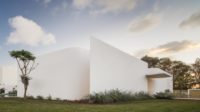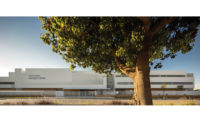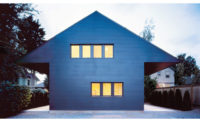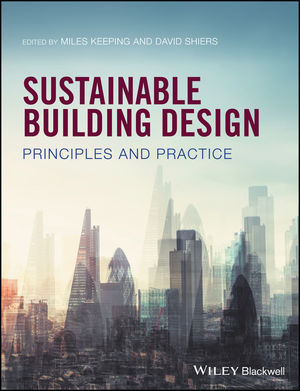Design Vanguard 2016: Mohamed Amine Siana
Traditional architecture informs a young practitioner’s beautiful and hypnotic contemporary forms.

Mohamed Amine Siana
Photo © Saad A. Tazi

Villa Z
A house for a doctor and his family on a busy street in Casablanca centers around the opacity of the main facade. The design combines principles of traditional architecture with a strong contemporary identity. Inside, a wall of Moroccan green onyx is a focal point of the living area.
Photo © doublespace photography

Technology School of Guelmim
Organized along a north–south axis through a partly covered path, the various buildings of this 75,000-square-foot project consist of an amphitheater, library, classrooms, workshops, laboratories, teachers’ offices, and staff housing. The architecture is deliberately massive and plays with the contrast between interior and exterior.
Photo © Fernando Guerra FG+SG

Villa F
For this 4,800-square-foot residence in Casablanca, the architect used local materials, including Moroccan marble and redwood, and designed some of the furniture. Eschewing air-conditioning, the design reinterprets the traditional patio on the first level to passively cool the house.
Photo © Fernando Guerra FG+SG

Laayoune Technology School
At this complex far from the city center, the various buildings are fragmented to allow maximum natural ventilation. They are connected by a series of exterior paths and covered squares and gardens. Different sun-protection devices, including brise-soleils, double skins, and protected walkways, are used.
Photo © doublespace photography





Architects & Firms
Casablanca, Morocco
During its 44 years under colonial rule, Morocco served as a petri dish for experiments in modernism by French architects and planners like Jean-François Zevaco and Michel Ecochard. Today, 38-year-old architect Mohamed Amine Siana attempts to reconcile traditional North African architecture with that movement’s imposition on the built environment, in both public and residential buildings. “I try to find a solution to the schizophrenia of our culture in Morocco,” he says. “We are forced to find a language to create a contextual modernism.”
Siana did not intend to become an architect, but his father strongly encouraged him to apply to the National School of Architecture in Rabat, from which he graduated in 2004. For him, the discipline came to represent an expression of culture, people, and sociological behavior. At school, he met classmates Saad El Kabbaj and Driss Kettani, and, over a period of eight years, they pooled resources to work together on the design of three OPEC-funded universities located in Morocco’s tertiary cities of Taroudant, Guelmim, and Laayoune. Each campus comprises a collection of low-rise cubic buildings arrayed around a central axis for the circulation of students and faculty. The schools also share a material palette—distinct rough-hewn ochre cement facades reference the rammed earth used in a medieval city wall at Taroudant, where the architects received their first joint commission.
Limited budgets and the extreme Saharan climate constrained their designs and forced the trio to explore how traditional Berber and Arab architecture contended with desert winds and heat. Research into Arabic medina city planning inspired their inclusion of courtyard gardens typical of the traditional Moroccan house, or riad, within cellular clusters of buildings grouped off the campus’s main axis. To further defend against the sun’s rays, classroom buildings are windowless on the east and west facades. Conversely, courtyard-facing ventilating windows on their north and south facades bring in the gardens’ cooling air. Remarkably, the buildings possess no air-conditioning in a climate that sometimes reaches 118 degrees Fahrenheit. Siana maintains that use of brise-soleils and deeply inset porticos and windows help shield the buildings from sand and sun, and also encourage exploration, creating a sense of mystery through “a vocabulary of hidden spaces.”
Siana established his own practice in 2007. He expands and contracts his staff to adapt the level of expertise and work needed to each commission. Villa Z, his recent residential project in Casablanca, incorporates the passive ventilation learned from the university projects but breaks with those buildings’ rigorous right-angled formalism. Its street-facing blind wall facade undulates, folds in on itself, and juts out like a sharp shard, while windows on the opposite side open to a swimming pool through a double- story shaded portico—an expressive example of how the medina’s inward-facing logic doesn’t have to be closed off to new interpretations.
Mohamed Amine Siana
FOUNDED: 2007
DESIGN STAFF: 4
PRINCIPALS: Mohamed Amine Siana
EDUCATION: National School of Architecture, Rabat, M.Arch., 2004
WORK HISTORY: El Kabbaj Kettani Siana Architects, 2005-07
KEY COMPLETED PROJECTS: Villa F, Casablanca, 2015; Villa Z, Casablanca, 2014. With Saad El Kabbaj and Driss Kettani: Laayoune Technology School, 2014; Technology School of Guelmim, 2011; Taroudant University, 2010 (all in Morocco)
KEY CURRENT PROJECTS: Lycée Lyautey, Casablanca (with Saad El Kabbaj, Driss Kettani, and ANMA), 2018–19; IMM 3B Residential Building, Casablanca, 2016; Villa W, Casablanca, 2017; Villa K, Casablanca, 2018










